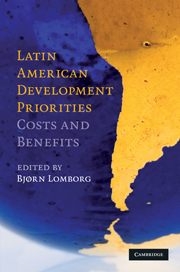Book contents
- Frontmatter
- Contents
- List of figures
- List of tables
- List of contributors
- Acknowledgments
- Abbreviations and acronyms
- Expert panel findings
- Introduction
- Democracy
- Education
- Employment and social security
- Environment
- Fiscal problems
- Health
- Infrastructure
- Poverty
- Public administration
- Violence and crime
- 10 Violence and crime in the LAC region
- 10.1 Violence and crime: an alternative view
- Conclusion
- References
10.1 - Violence and crime: an alternative view
Published online by Cambridge University Press: 05 June 2012
- Frontmatter
- Contents
- List of figures
- List of tables
- List of contributors
- Acknowledgments
- Abbreviations and acronyms
- Expert panel findings
- Introduction
- Democracy
- Education
- Employment and social security
- Environment
- Fiscal problems
- Health
- Infrastructure
- Poverty
- Public administration
- Violence and crime
- 10 Violence and crime in the LAC region
- 10.1 Violence and crime: an alternative view
- Conclusion
- References
Summary
Overview of chapter 10
Chapter 10 (i) reviews the evidence on levels and trends in crime and violence in the LAC region; (ii) discusses, in summary fashion, the evidence on good practices in crime and violence reduction; and (iii) presents four proposed solutions for LAC countries, with BCRs provided for three of the four proposed solutions.
Cohen and Rubio recognize the heroic nature of the quest to provide a CBA of crime and violence prevention initiatives for Latin America:
Unfortunately, most of the evidence [on what works is] … in the United States and to a lesser extent in the United Kingdom or Europe … The few programs [in the LAC region] that have been evaluated or reported on as being promising have not had the benefit of independent reviews and thus should not be considered as reliable evidence. Indeed, it is not easy to find even a rough inventory of what is being done.
Faced with such a weak knowledge base from which to formulate public policy recommendations, Cohen and Rubio have few options. They adopt an eminently sensible strategy: survey the developed-country literature on what works and what doesn't; locate B/C estimates for those interventions which have been identified as having been successful in reducing crime; and propose as solutions for the region some of the interventions with attractive BCRs.
- Type
- Chapter
- Information
- Latin American Development PrioritiesCosts and Benefits, pp. 680 - 692Publisher: Cambridge University PressPrint publication year: 2010



